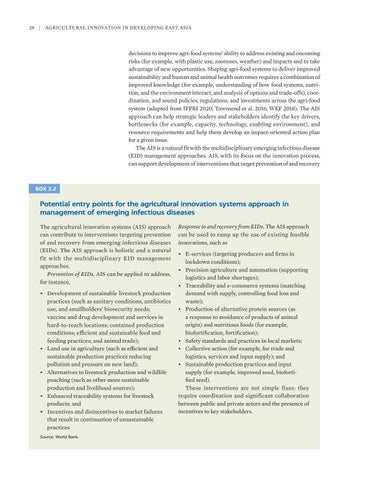28 | Agricultural Innovation in Developing East Asia
decisions to improve agri-food systems’ ability to address existing and oncoming risks (for example, with plastic use, zoonoses, weather) and impacts and to take advantage of new opportunities. Shaping agri-food systems to deliver improved sustainability and human and animal health outcomes requires a combination of improved knowledge (for example, understanding of how food systems, nutrition, and the environment interact, and analysis of options and trade-offs), coordination, and sound policies, regulations, and investments across the agri-food system (adapted from IFPRI 2020; Townsend et al. 2016; WEF 2018). The AIS approach can help strategic leaders and stakeholders identify the key drivers, bottlenecks (for example, capacity, technology, enabling environment), and resource requirements and help them develop an impact-oriented action plan for a given issue. The AIS is a natural fit with the multidisciplinary emerging infectious disease (EID) management approaches. AIS, with its focus on the innovation process, can support development of interventions that target prevention of and recovery
BOX 3.2
Potential entry points for the agricultural innovation systems approach in management of emerging infectious diseases The agricultural innovation systems (AIS) approach can contribute to interventions targeting prevention of and recovery from emerging infectious diseases (EIDs). The AIS approach is holistic and a natural fit with the multidisciplinary EID management approaches. Prevention of EIDs. AIS can be applied to address, for instance, • Development of sustainable livestock production practices (such as sanitary conditions, antibiotics use, and smallholders’ biosecurity needs; vaccine and drug development and services in hard-to-reach locations; contained production conditions; efficient and sustainable feed and feeding practices; and animal trade); • Land use in agriculture (such as efficient and sustainable production practices reducing pollution and pressure on new land); • Alternatives to livestock production and wildlife poaching (such as other more sustainable production and livelihood sources); • Enhanced traceability systems for livestock products; and • Incentives and disincentives to market failures that result in continuation of unsustainable practices Source: World Bank.
Response to and recovery from EIDs. The AIS approach can be used to ramp up the use of existing feasible innovations, such as • E-services (targeting producers and firms in lockdown conditions); • Precision agriculture and automation (supporting logistics and labor shortages); • Traceability and e-commerce systems (matching demand with supply, controlling food loss and waste); • Production of alternative protein sources (as a response to avoidance of products of animal origin) and nutritious foods (for example, biofortification, fortification); • Safety standards and practices in local markets; • Collective action (for example, for trade and logistics, services and input supply); and • Sustainable production practices and input supply (for example, improved seed, biofortified seed). These interventions are not simple fixes: they require coordination and significant collaboration between public and private actors and the presence of incentives to key stakeholders.

